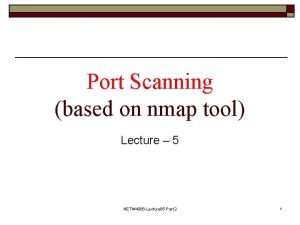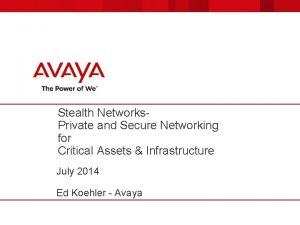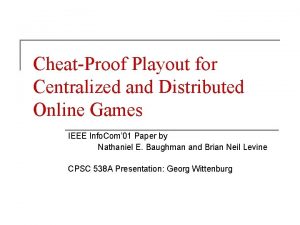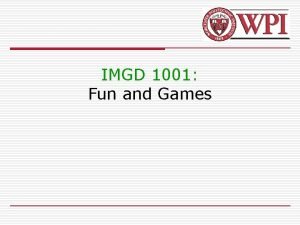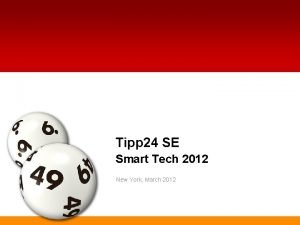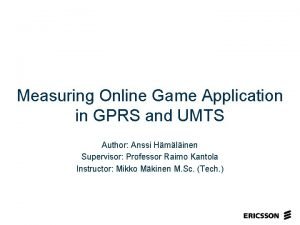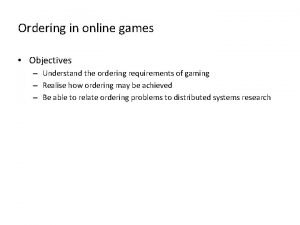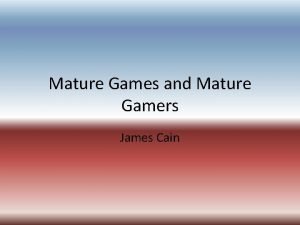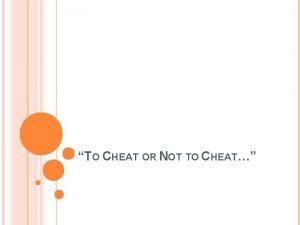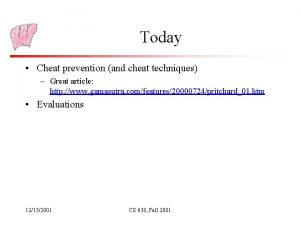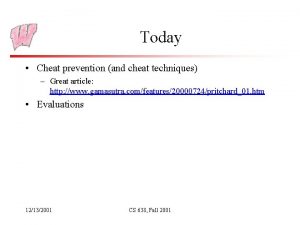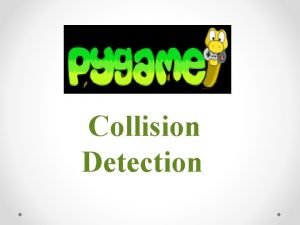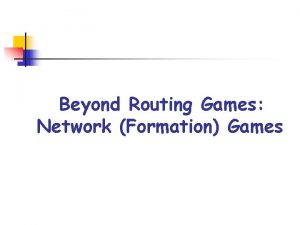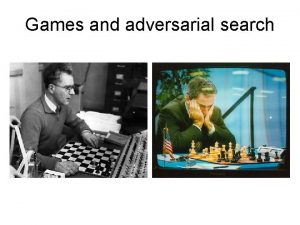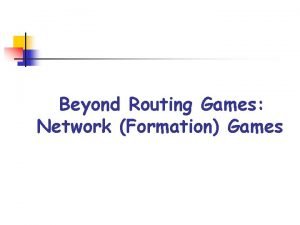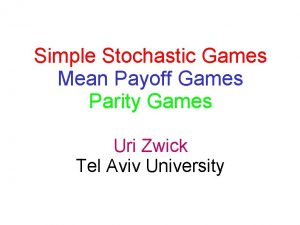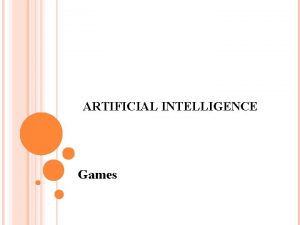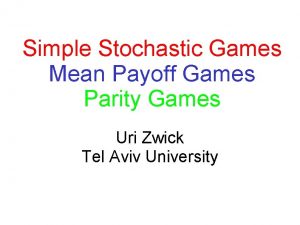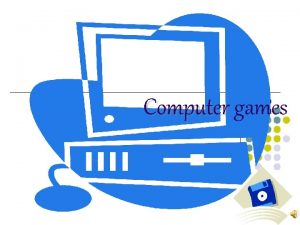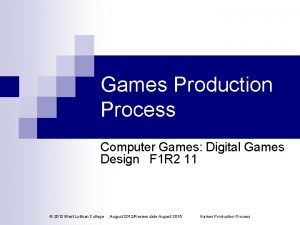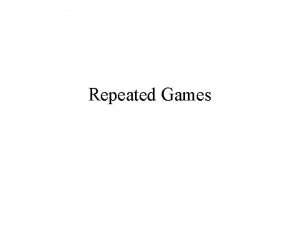Stealth Measurements for Cheat Detection in Online Games
























- Slides: 24

Stealth Measurements for Cheat Detection in On-line Games Ed Kaiser Wu-chang Feng Travis Schluessler

Cheating Affects On-line Games • Frustrates legitimate players • not fun to play against cheaters • can't tell if good opponents are cheating or not • Impacts profitability of game developer • existing players quit in frustration • bad reputation inhibits potential new players Net. Games 2008 Ed Kaiser 2

The Cheating Problem • On-line games simulate environments too complex for a server to render for its clients • Client is trusted to run the game accurately • obey physics • keep secrets from player • Cheat is software that abuses the trust • accomplish feats that the cheater is unable or unwilling to do Net. Games 2008 Ed Kaiser 3

Cheater has the Upper Hand … • They have complete control of machine • grant cheat software any privileges necessary • they get to run first • Use advanced techniques of adversary in ‘hard’ security problems (like Rootkits) • cloaking / timely unloading • debugging / virtualizing game • spoofing / disabling its defenses Net. Games 2008 Ed Kaiser 4

… but Cheating is a Weak Threat • ‘Security breach’ is not catastrophic • private data is not stolen • machine is not used to attack network hosts • can easily undo the damage • No urgency for detection and capture • cheater is connected for long periods • cheats target small portion of system Net. Games 2008 Ed Kaiser 5

Detection is Sufficient • Cheater will eventually be caught • Clean up is easy • ban the account • undo results of winning • Cost of being caught is high • loss of CD-key ($30 to $50) • loss of paid subscription ($10 per month) • voiding any time they actually invested Net. Games 2008 Ed Kaiser 6

Our Approach • Detect cheaters using hardware-based measurements • securely • stealthily with regard to • what is being measured • when measurements are made Net. Games 2008 Ed Kaiser 7

Cheating by Manipulating Data 1) Authorized Automated Read • collect information presented to user • use Graphics Device Interface Bit. Blt() to learn state from screen 2) Unauthorized Data Read • reveal state meant to be secret • Read. Process. Memory() 3) Unauthorized Data Write • directly modify game state • static data (i. e. gravity constant) • dynamic data (i. e. as player location) • Write. Process. Memory() Net. Games 2008 Ed Kaiser 8

Cheating by Modifying Code 4) Code Injection • modify game code or add cheat code • overwrite game code (hot patch) • inject code into pockets of allocated but unused executable memory (code caves) • allocate memory with Virtual. Alloc. Ex() and fill it with code • load Dynamic Link Library containing cheat code (DLL injection) • using Load. Library() • modifying the App. Init_DLL registry entry Net. Games 2008 Ed Kaiser 9

Cheating by Changing Execution 5) Direct Function Calls • execute game or OS functions to change state • input using keybd_event() or mouse_event() 6) Thread Manipulation • execute code using a thread within the game process • inject a new thread via Create. Remote. Thread() • hijack an existing thread (detour or trampoline) 7) Function Pointer Hooks • redirect function pointers (hook) to cheat code • • Import Address Table (IAT) Interrupt Descriptor Table (IDT) overwrite return address on stack overwrite Secure Exception Handler (SEH) and raise exception Net. Games 2008 Ed Kaiser 10

Cheating by Changing the Game 8) External Processes • control or modify the game from another process • Debug. Active. Process() to control game execution • use Send. Message() to send input to the game window 9) File Replacement • change game files or build a new game client • modify opponent models to be bigger / brighter • build a new game client or automation robot that speaks the game’s network protocol Net. Games 2008 Ed Kaiser 11

Cheating through Hardware 10) Exploit Hardware Facilities • use registers, hardware debugging, or virtualization features to manipulate the game • modify Interrupt Descriptor Table Register (IDTR) to point to a different table of handlers • modify control and segment registers (CR 0 through CR 3) to change page-write permission • hardware debugging • run the game using hardware virtualization Net. Games 2008 Ed Kaiser 12

eg. War. Craft III Maphack After Before • unauthorized write • code injection (hot patch) • NOP over visibility check code Net. Games 2008 Ed Kaiser 13

Measuring Memory 1) Code Integrity • integrity check of existing code • game and loaded DLL “. text” segments will reveal hot patches, detours 2) Function Pointer Validation • integrity check function pointer tables • game and loaded DLL “. idata” segments will reveal IAT hooks 3) Static Game Data Validation • integrity check invariant game data • reveals unauthorized static data writes (eg. gravity constant) Net. Games 2008 Ed Kaiser 14

Measuring more Memory 4) Scan for Injected Pages • scan for pages inexplicably marked as executable 5) Stack Validation • check that stack represents legal call chain • reveals thread hijacking, thread injection, code injection, debugging and virtualization 6) Memory Watchpoints • log changes to dynamic data • reveals unauthorized dynamic data writes (eg. player team) Net. Games 2008 Ed Kaiser 15

Measuring Execution Behavior 7) Instruction Counts • check distribution of opcode type 8) Check Execution Range • observe range of execution through EIP register 9) Code Timing • count cycles to go through game's event loop 10) System Call Behavior • check distribution and sequence of system calls Net. Games 2008 Ed Kaiser 16

Measuring I/O, Registers, and File 11) I/O Path Validation • verify a raw I/O signal corresponds to every mouse and keyboard event 12) Register Monitoring 13) File Integrity 14) Environment Validation Net. Games 2008 Ed Kaiser 17

System Architecture Game Client Game Server Player Account Auditor Controller Request Data • Auditor reads game state • Controller decides what & when to sample • compares measurement to expected state • alters player account when caught cheating Net. Games 2008 Ed Kaiser 18

Stealth Measurements • Run Auditor on Management Engine (ME) • safe from software or OS interference • can observe memory, I/O, and network traffic • secure (authenticated and encrypted) network channel to Controller CPU Memory Controller Game Auditor (ME) I/O Controller Network Controller Memory Peripherals Interfaces OS Net. Games 2008 Ed Kaiser 19

Possible Stealth Measurements Measurement Cheats Caught Code Integrity Code Timing Code Injection Thread Hijacking File Modification Unauthorized Data Writes File Modification DLL Injection Code Caves Thread Hijacking Thread Injection Direct Game Function Calls Function Pointer Hooks IDTR Tampering Direct Function Calls Static Data Integrity Scan of Executable Pages Check Execution Range Stack Validation I/O Path Validation Net. Games 2008 Ed Kaiser 20

What Could Improve the System? • Better CPU and memory monitoring Measurement Cheats Caught Instruction Counts Interrupt Counts Code Injection Thread Manipulation File Modification Hardware Facilities Authorized Data Reads Unauthorized Data Writes Register Monitoring Memory Watch Points Net. Games 2008 Ed Kaiser 21

Related Work • Classification • J. Yan and B. Randell. A Systematic Classification of Cheating in Online Games. Net. Games 2005. • Y. Lyhyaoui, A. Lyhyaoui, and S. Natkin. Online Games: Categorization of Attacks. Eurocon 2005. • Hardware-based Cheat Detection • T. Schluessler, E. Johnson, and S. Goglin. Is a Bot at the Controls – Detecting Input Data Attacks. Net. Games 2007. Net. Games 2008 Ed Kaiser 22

Conclusions • Cheating is bad • Cheats are advanced • large range of cheat methods • Detection catch them • many detection methods • Hardware supports stealth measurements • can catch most cheats • Additional support could catch more cheats Net. Games 2008 Ed Kaiser 23

Thanks Net. Games 2008 Ed Kaiser 24
 Stealth scanning technique
Stealth scanning technique Level building for stealth gameplay
Level building for stealth gameplay Stealth network design
Stealth network design Types of games outdoor
Types of games outdoor Hunger games chapter 3 questions
Hunger games chapter 3 questions Roadtrip games
Roadtrip games Cheating online games
Cheating online games 1001 online games
1001 online games Tipp24 online games
Tipp24 online games Measuring online games
Measuring online games Objectives of online gaming
Objectives of online gaming Www.muzzyclub.com
Www.muzzyclub.com Mature online games
Mature online games Bris för vuxna
Bris för vuxna Bra mat för unga idrottare
Bra mat för unga idrottare Argument för teckenspråk som minoritetsspråk
Argument för teckenspråk som minoritetsspråk Etik och ledarskap etisk kod för chefer
Etik och ledarskap etisk kod för chefer Datorkunskap för nybörjare
Datorkunskap för nybörjare Ellika andolf
Ellika andolf Vad står k.r.å.k.a.n för
Vad står k.r.å.k.a.n för Steg för steg rita
Steg för steg rita Redogör för vad psykologi är
Redogör för vad psykologi är Ministerstyre för och nackdelar
Ministerstyre för och nackdelar Claes martinsson
Claes martinsson Lek med geometriska former
Lek med geometriska former
